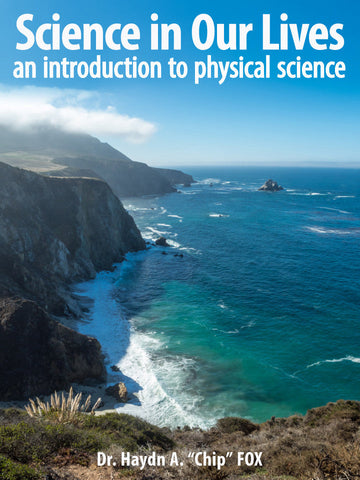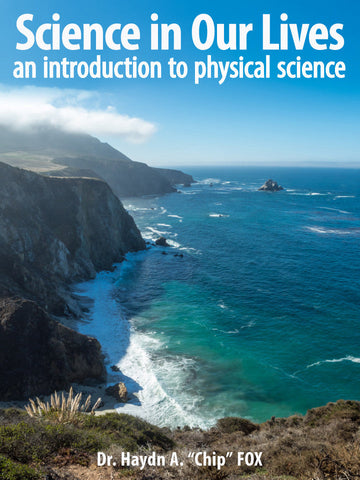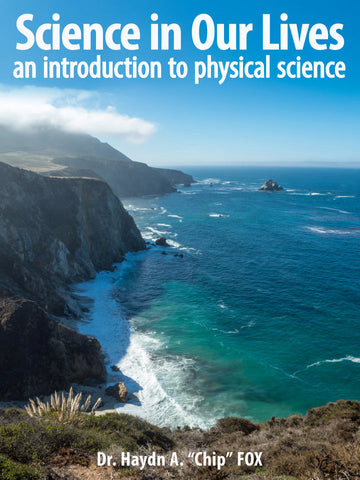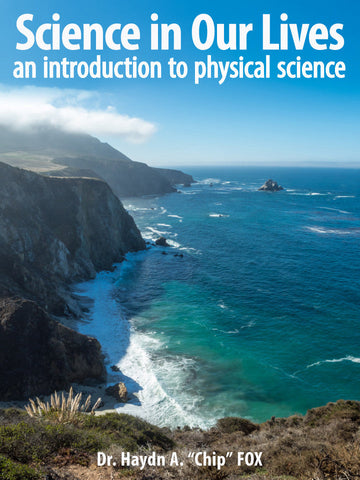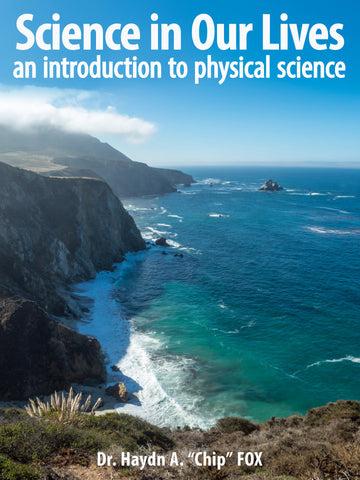
- Science in Our Lives - Purchase for Individual Use (NOT FOR A COURSE)
Important: If you are a student interested in purchasing a copy of this book for your class, you should search for your school, course name, or professor. Each instructor has a unique book created for their course, which you will not be added to if you purchase this version of the text. Digital textbooks on the Trunity eLearning platform also include interactive quizzes and other material for your class, so it is very important that you purchase the correct course.
If you are a student, please click here to find your course.
If you are an educator planning on adopting this book for your class, please click here to request an examination copy.
Overview
Science In Our Lives includes physics, chemistry, cosmology (astronomy), geology, meteorology, and oceanography in an approachable manner. The text was written with the belief that students are capable of understanding almost any scientific principle if presented to them in a way that connects with their previous personal or academic experience, is of sufficient interest to entice learning of new concepts, and is written as if a real person is talking to them at their own level. The text presents concepts to students in a simple, step-by-step understandable way while communicating at a mature level. It assumes minimal science background while respecting normal adult intelligence. To aid in this, useful analogies are given throughout the text that connect difficult concepts to familiar everyday experiences. As with most texts, each chapter begins with an opening story or opening scenario that typically involves some interesting and familiar phenomena that results from the scientific principles to be discussed within the chapter. For example, electric eels are discussed in the opener to the chapter on electricity, Star Wars’ photon weapons and light sabers introduce the chapter electromagnetic radiation, Pluto’s demotion from its status as a planet introduces the chapter on the solar system, and a trip to a black hole begins the chapter on the universe.
Mathematics is presented as painlessly as possible without sacrificing thoroughness. In the first chapter, a step-by-step problem-solving strategy is given to help students in figuring out their math problems. Within chapters, “worked examples” are given for each type of mathematical problem the students will encounter. After each worked example, a set of five questions, along with their answers, is given in “Check Your Problem-Solving Ability.” Mathematical equations are given first in words and then in letter symbols.
Chapter sections all begin with two or three “Inquiry” questions designed to stimulate student interest. These ask questions that a lay-person might ask about the scientific principles behind phenomena being discussed, and of course the questions are answered within the section. Chapter sections are not artificially kept to a standard length for bite-sized consumption, but instead are divided and presented as logically as possible to give full explanations and understanding of the section topic.
The standard text features are also present: Key terms appear in bold (are clickable for their definitions), interest boxes relate to the history of science or interesting technology, key concepts, such the first law of thermodynamics or Newton’s first law of motion, are emphasized by color-highlighted boxes. End-of-Chapter material includes key terms, key equations, web activities, and “Coming Up Next” previews of the next chapter.
In summary and as is the intent of Science In Our Lives, you will find this text to be very well rounded, interesting, fun, and educational for your students. And because of its style, you will find it a real pleasure to use in your physical science classes.
Table of Contents
Preface
Chapter 1: The World of Science: Methods and Tools for Understanding the Physical Universe
Chapter 2: Size and Scale: Putting Things in Perspective
Chapter 3: Laws of Motion: Mechanics
Chapter 4: Thermodynamics: Principles of Energy and Heat
Chapter 5: Fluids: Pressure, Density, and Buoyancy
Chapter 6: Mechanical Waves: A Transfer of Energy
Chapter 7: Light: The Dual Nature of the Electromagnetic Spectrum
Chapter 8: Electricity: The Flow of Electrons
Chapter 9: Chemical Elements: The Components of Everything
Chapter 10: Working with Chemistry: Equations and Relationships
Chapter 11: Chemistry Applications: Relevance in Everyday Life
Chapter 12: The Universe: Stars, Galaxies, and the Ultimate Fate of the Universe
Chapter 13: The Solar System: Planets, Moons, and Other Objects
Chapter 14: Part IV Astronomy: Earth: Our Planet’s Place in the Solar System
Chapter 15: Rocks and Minerals: Earth’s Building Blocks
Chapter 16: Plate Tectonics: Earth’s Surface in Motion
Chapter 17: Geomorphology: Shaping Earth’s Landscapes
Chapter 18: The Atmosphere: Composition, Structure, and Environmental Concerns
Chapter 19: Meteorology: The Study of Earth’s Weather
Chapter 20: Oceanography: The Science of the Ocean
Chapter 21: Periodic Table of Elements
About the Illustrator
About the Author
Born in Grand Rapids, Michigan, Dr. Haydn A. “Chip” Fox received a bachelor’s degree in theology and journalism from Ambassador College in Big Sandy, Texas, in 1971. He spent the next 15 years in several non-academic pursuits, such as managing convenience stores, driving an 18-wheeler, and working for a newspaper. In 1986, he returned to college with the intent of becoming a high school science teacher. His interests in science education, environmental science, and in particular, the Earth sciences, were immediately sparked, and in 1992 he received a Ph.D. in geological sciences and science education from the University of South Carolina.
Chip has served on the faculty at Southeast Missouri State University, Clemson University, and Texas A&M University–Commerce. He is currently Associate Dean of the College of Science & Engineering at Texas A&M University–Commerce. Having spent years in non-academic careers, Chip understands the challenges his students will face when they graduate from college. He enjoys an excellent rapport with his students, a group that includes—in addition to groups of non-science majors—future environmental professionals and public school teachers. Chip lives with his wife, Donna, in Commerce, Texas.
We Also Recommend

